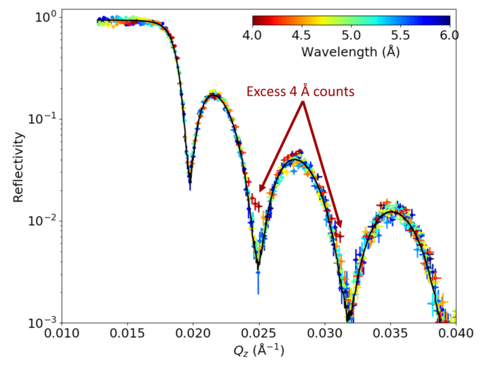CHRNS: CANDOR background reduction
Each CANDOR bank comprises 54 individual HOPG analyzer crystals, each selecting neutrons from the scattered neutron beam of a particular wavelength. The reflectivity curve is reconstructed from the contributions from each individual analyzer (see graphic).

During commissioning, two rate-dependent sources of background were discovered in the detector:
Neutrons that are not detected in any of the HOPG crystals strike a beam stop at the end of the detector. The original beam stop was made of a flexible borated polymer. Neutrons were being scattered backwards from this material into the scintillators associated with low-wavelength (≈ 4 Å) neutrons, causing an excess of counts at these wavelengths and a deviation from the correct reflectivity curve (see graphic). The beam stop has been replaced with borated glass to provide additional absorption of excess neutrons and to prevent spurious detections at low-wavelength end of the detector.
The width of the entrance to each detector bank defined by a mask. This mask material was originally made of borated aluminum; however, in intense scattered beams, neutrons would scatter from the mask and be detected in the long wavelength (≈ 6 Å) channels. During the outage, this mask was augmented by a thin layer of Gd to absorb, rather than scatter, any neutrons that strike the mask.
In addition, because the reflectivity curve is built from the signal from many detectors, it is particularly important that the dark count rate over the entire detector be as low as possible. During commissioning, it was observed that the dark count rate in the detector depended strongly on the intensity of the beam impinging on the pre-sample slit. This suggested that additional shielding was required between the sample position and the detector; preliminary tests indicated that a small amount of borated rubber eliminated the dependence of the dark count rate on beam flux. During the outage, the entire detector assembly was wrapped in borated rubber shielding.
References
[1] D. Hoogerheide et al. Journal of Applied Crystallography 55, 58-66 (2022).


